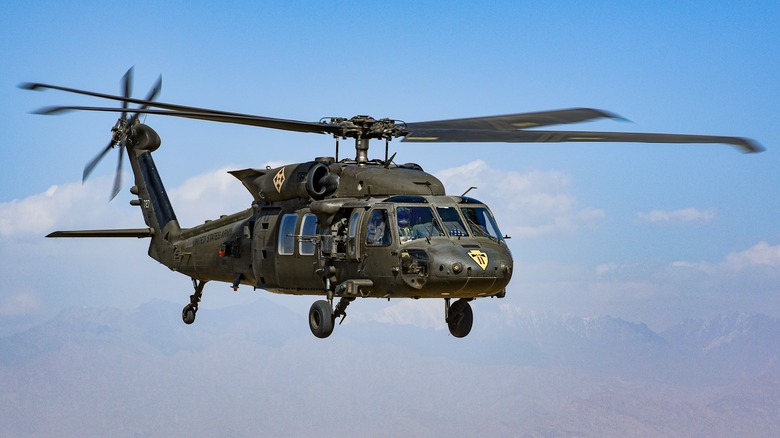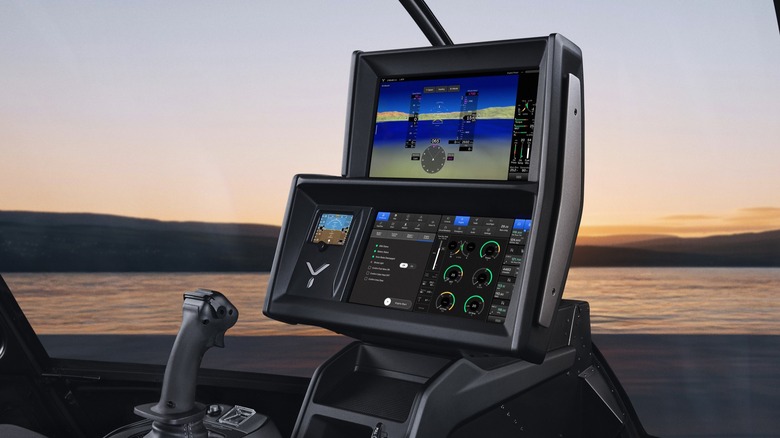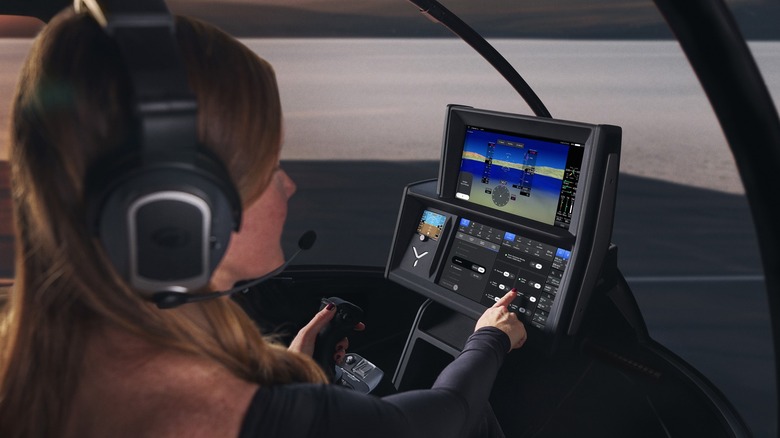Black Hawk Helicopters Are Getting Smarter And Are Almost Ready To Fly Themselves
It's not hyperbole to say that for over 40 years, the UH-60 Black Hawk has been the U.S. Army's workhorse helicopter. It entered the inventory in 1979 as a replacement for the UH-1 Iroquois, known as the Army's "Huey" helicopter, and it's filled that role well. The Army, Navy, Air Force, and Coast Guard all operate their own variants, and more than 5,000 have been built.
Like other aircraft in the military's inventory, the one flying today is significantly different than the first model. The Black Hawk has undergone numerous upgrades to bring it up to 21st-century standards and requirements, and another update is on the way. In January 2025, the U.S. Army announced a new partnership with Skyryse, which created the world's first universal operating system for flight, to improve the Army's massive fleet of over 2,100 Black Hawk helicopters. The plan is to incorporate the company's SkyOS, which boasts numerous highly automated capabilities, to improve the Black Hawk by making it easier to train pilots, increase the ability of any pilot familiar with other aircraft to fly one, and automate previously manual tasks.
The updates will not create a new variant of the UH-60; instead, they will make the existing model easier to fly. Initially, SkyOS' integration will target the Army's helicopters — the bulk of the U.S. military's inventory — but should things progress, other branches' choppers may receive similar upgrades. Here's what the partnership is expected to accomplish.
What SkyOS brings to the table
Skyryse said that its partnership with the Army is meant to "make military helicopters like the Black Hawk simpler and safer." Mark Groden, the company's CEO, added: "By combining the Army's operational expertise with Skyryse's leadership in rotorcraft flight controls and automation, we have a unique opportunity to make flying simple and safe enough that any serviceperson can fly any aircraft."
Reducing training time is enticing, as it can take two to three years to turn a civilian off the street into a pilot for the U.S. Army. The longer timeline includes non-pilot training like basic training and Officer Candidate or Warrant Officer Candidate School. Still, that's a long time, but by incorporating SkyOS, new artificial intelligence features will improve fly-by-wire — the aircraft's electronic system that replaces manual controls — with a simpler control system, suggesting that nearly anyone could potentially pilot a Black Hawk with significantly less training.
Skyryse touts a single control stick, two touchscreen interfaces to simplify flying the aircraft, three types of redundancy, 3D synthetic vision with the ability to alert the pilot to dangerous terrain, and full control at the pilot's fingertips. Hovering, one of a helicopter's key characteristics, is assisted by removing the need to use both hands and feet, replacing it with a single command on a touchscreen that enables stable hover at any time. This alone makes the integration of SkyOS an ideal upgrade to any military helicopter.
What's next for the UH-60 and SkyOS?
Skyryse says SkyOS can fully integrate into anything that flies, from helicopters to fixed-wing aircraft. This suggests that its agreement with the Army could widen to incorporate additional aircraft. Meanwhile, incorporating the software into Black Hawk helicopters will require upgrades to their existing flight control systems. SkyOS requires at least two touchscreens and must be hardwired into the helicopter to be properly integrated, which will take some time and cost a good amount of money.
The system can be fitted into any aircraft — part of its appeal to the military. Ideally, SkyOS and its requisite hardware would make it possible for anyone to pilot a Black Hawk with minimal training, as it's immediately recognizable by anyone familiar with touchscreen technology. Granted, the Army isn't about to ditch its training program, but it can be streamlined, making it shorter, cheaper, and more efficient. The announcement of Skyryse's partnership with the Army didn't indicate the cost to taxpayers, though that information will eventually be released.
It also failed to mention the time required to incorporate the system into the Army's Black Hawks, as well as other unspecified aircraft. Because of this, it's unclear when the reconfigured choppers will return to the skies. Previously, Lockheed Martin received $6 million to convert a single Black Hawk into an autonomous helicopter, but that was a much smaller contract. Skyryse's deal could be significantly more costly, given the scope of retrofitting thousands of existing Army helicopters.


